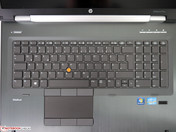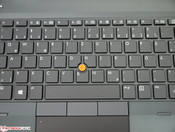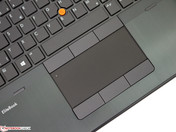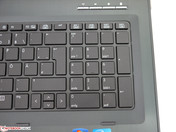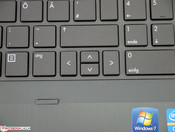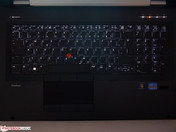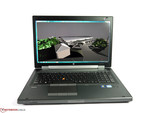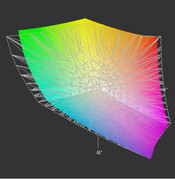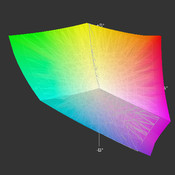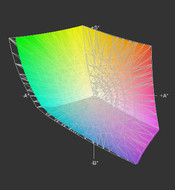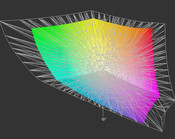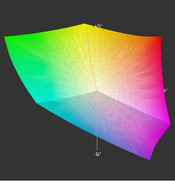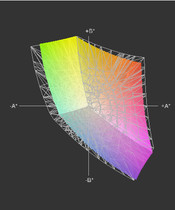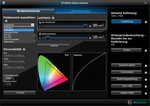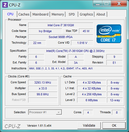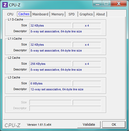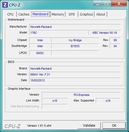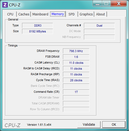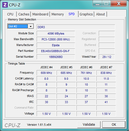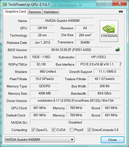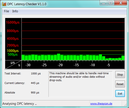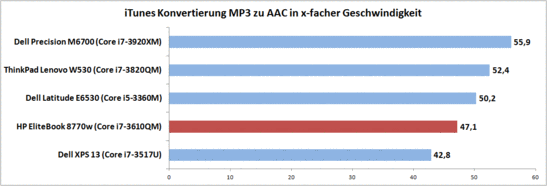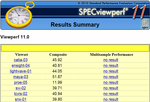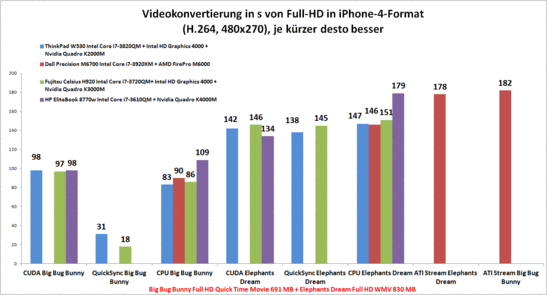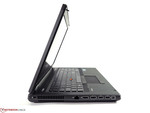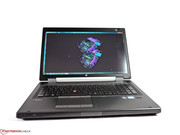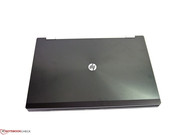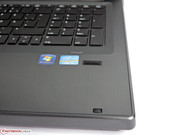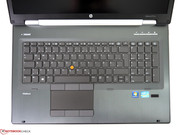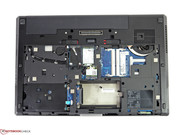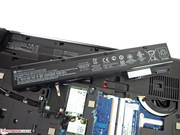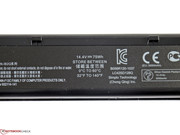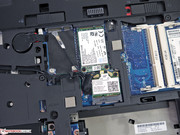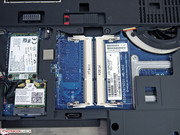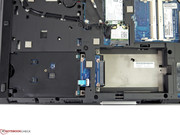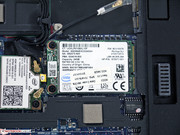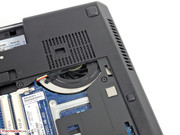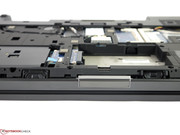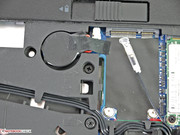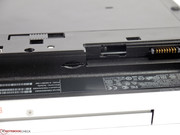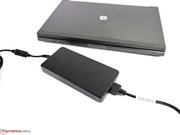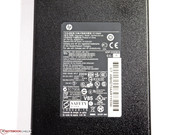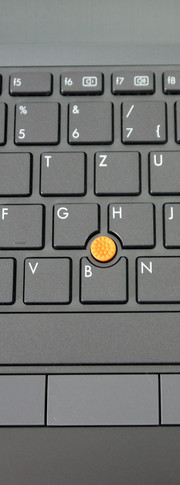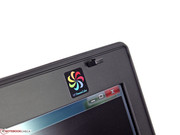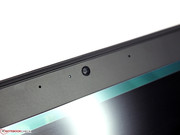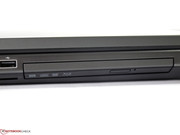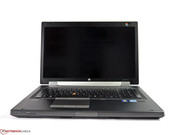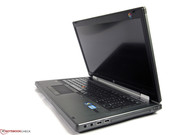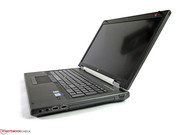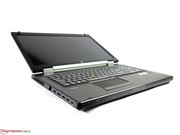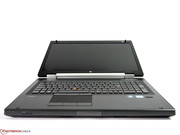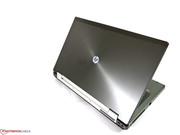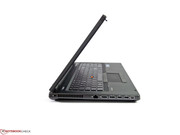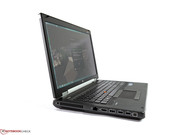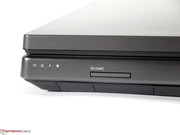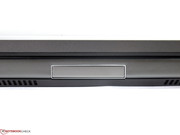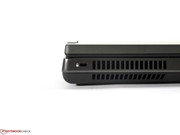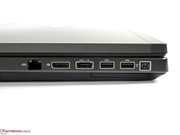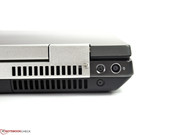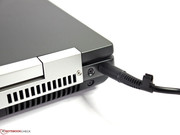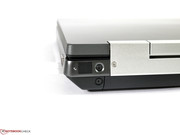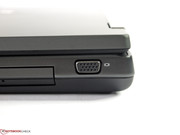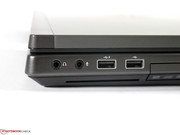Review HP EliteBook 8770w DreamColor Notebook

For the original German review, see here.
The workstation portfolio of Hewlett Packard is extensive. The offering ranges from 15- to 17-inch models (even a few mobile 14-inch models are included). The two smaller workstations, HP EliteBook 8470w and HP EliteBook 8570w, have proven their worth in past reviews. Now, we take a look at the HP EliteBook 8770w. The large top model offers a few unique features: the strongest hardware and most extensive configuration options. The large case offers a lot of space and good cooling. Our test model will have to compete with models from HP and other manufacturers. For example, the Dell Precision M6700, the Fujitsu Celsius H920 and Bullman's E-class are very powerful, 17-inch workstations with many appealing features.
The HP EliteBook 8770W offers 12 different configurations. The prices start at 1,650 Euros (~$2,202) and end at 5,000 Euros (~$6,674). The variety of available components is as large as the price span. A multitude of Intel Core i5 and Intel Core i7 processors cover the CPU section. Four different professional graphic cards and three different displays make up the graphics section. Next, the configuration lists a variety of RAM modules and storage devices. The OS is Windows 7 Professional, as Windows 8 is currently only available here and there.
Our test model uses an Intel Core i7-3610QM CPU, an Nvidia Quadro K4000M graphics card, 8 GB RAM, a 750 GB HDD, 24 GB SLC cache module, Windows 7 Professional and the infamous DreamColor display with RGB LEDs. The price lies at 4,300 Euros (~$5,739).
Case
The heavy case is made of different shades of metal which creates an intriguing green-grey color scheme. The tapered sides give the model a slimmer look. The test model weighs 3.92 kg (according to HP - minimum is 3.47 kg with SSD and empty modules). Combined with the 1 kg power adapter, bag and accessories, the set will weigh up to 6 kg.
The high weight translates to high stability, as the various tests of the MIL-STD810G standard will attest. The entire work area, including the hand-rest regions and the keyboard, is sturdy. Only the area around the "Enter" key is prone to bend a little. The hinges do a good job of keeping the screen in position, while allowing the user to open the laptop with a single hand. The laptop base does not rise when it is opened. The display border can be bent a little, but in comparison to the competition, it is very sturdy.
The bottom of the laptop is a mix of synthetic material and metal. The battery is placed at the rear, secured by a slide mechanism. A second slider unlocks the large bottom flap which hides most of the hardware. Thankfully, the user will not have to remove any screws. The rubber feet are placed directly onto the case.
Connectivity
The connectivity lives up to the high workstation standard: the model includes almost everything a professional user would wish for. Just exotic interfaces, such as Thunderbolt or a 6-pin FireWire interface, are not included. However, the latter can be added by using the ExpressCard slot. External displays can be connected using the DisplayPort or analogue VGA. The rear boasts an opening for an analogue modem and the card reader is accessible at the front.
The number and variety of interfaces is impressive, but their positioning and distribution is not optimal. At the front left side, the most important ports are grouped tightly together. The network, DisplayPort, eSATA, 2 x USB 3.0 and FireWire interfaces will inconvenience users when occupied. On the right side, the VGA is placed in the back, but the standard USB 2.0 port is too far in front. Users who require a lot of peripheral devices in stationary use should consider purchasing a docking port.
Communication
The EliteBook 8770w is equipped with everything the heart desires. Sadly, the selection is slightly limited for the test model with the DreamColor display - no HSPA or LTE modem can be combined with our model. The WLAN connectivity is provided by Intel's Centrino Advanced-N 6205 module. This module has two antennas and operates at the 2.4 and 5 GHz frequencies (theoretically up to 300 Mbit/s). Although this module supports Intel's Wireless Display technology, HP does not seem to have activated this function. Bluetooth 4.0, a 720p webcam and Gigabit LAN round off the interesting package.
Security
HP includes an extensive security packet for the EliteBook. Trusted Platform Module 1.2, fingerprint sensor, BIOS password, facial recognition, Smart Card reader and Computrace Anti Theft secure the laptop. These various features are controlled using HP's Security Manager ProtectTools, which can be found in the Control Panel. Additional information about notebook security can be found in our FAQ.
Accessories
As is typical, HP does not include accessories for the EliteBook 8770w. However, the manufacturer does offer a multitude of accessories for the workstation. Various optical drives, hard drives, SSDs and an empty module are offered for the Upgrade Bay. The HP Upgrade module includes a 750 GB hard drive (H2P66AA - 224 Euros, ~$299). A battery can not be installed in the slot like in the Dell Latitude E6530. HP's docking solution is also interesting. The HP Advanced docking station (2 x DVI and 2 x DisplayPort) can run up to 5 displays (AMD Eyefinity). Our test model can control up to 4 displays thanks to the Nvidia Quadro K4000M.
Maintenance
The large maintenance flap uses no screws. Thanks to the slide mechanism, it can easily and quickly be removed. This grants the user access to the most important hardware components. Although the cooler fan is half-covered, it is possible to clean it. The two RAM slots on the bottom are empty and offer room for upgrades. Two additional slots under the keyboard require more effort to find, but are important if the user plans to install more than 16 GB of RAM. Two regular slots and the Upgrade Bay are available for the storage devices. Although the second slot is empty in our test model, we did not receive a disk frame or screws in the delivery.
Warranty
The HP EliteBook 8770w has a 3 year warranty. Various extensions are available: for example, a 3 year "On-Site" service on the next workday worldwide will cost 180 Euros (~$240) in the HP Store.
Input Devices
Keyboard
The keyboard has normal-sized 19 mm keys and offers an additional numeric pad. Four different keys for WLAN, Mute, Browser and Calculator are also included. The cursor keys and the Enter key are a little small and are placed close to each other, leading to mistakes during a heated typing session. The key caption is clearly legible and the keyboard has backlighting.
The key lighting only has two brightness levels. The entire keyboard is seated securely and only gives way around the Enter key. The medium stroke distance combined with the soft, yet precise impact is pleasant. The noise is very conservative and does not distract the user.
Touchpad/ Pointstick
The Synaptics touchpad measures 111 x 51 mm - quite large. It offers sufficient space for the large multi-touch gestures. The standard settings include switching on/off of different gestures. The input surface has great slide properties, but only recognizes taps on the left two-thirds of the touchpad. We could not change this in the settings. The touchpad has the standard 3 keys and the pointstick adds to these with its own. All keys are well-accessible, responsive and offer a nice grip thanks to the rubber coating.
The pointstick presents a good alternative to a mouse or touchpad. The orange "stub" is slightly taller than the surrounding keys and the user will not have any trouble using it. The pointstick cannot be used to tap, but it does include keys, which offer similar quality to those of the touchpad.
Display
The HP EliteBook 8770w is available with 3 different matte displays. The standard screen has a resolution of 1600x900 pixels (106 dpi) and wide viewing angles. The "normal" Full HD display has 1920x1080 pixels (127 dpi) and also offers wide viewing angles. Both TN panels use backlight, which is made up of white LEDs. The DreamColor display of our test model has the Full HD resolution, an IPS panel and is lit up by RGB LEDs. This ensures great viewing angles and great color spectrum coverage.
The available resolutions are not limited. Standard resolutions, such as 1366x768 or 1600x900 pixels are supported as well as exotic variations like 1152x864 or 1600x1024 pixels.
| |||||||||||||||||||||||||
Brightness Distribution: 86 %
Center on Battery: 333 cd/m²
Contrast: 856:1 (Black: 0.389 cd/m²)
98.8% AdobeRGB 1998 (Argyll 3D)
99.9% sRGB (Argyll 3D)
99.9% Display P3 (Argyll 3D)
We measured a maximum brightness of 286 cd/m² (top right) - 333 cd/m² (center) at our nine measurement points. This results in an average of 312 cd/m². The brightness distribution is good: 86%. Single-color content will allow the user to recognize some brightness differences but this hardly affects use. The brightness can be regulated (20 levels). At level 15, the user has 159 cd/m², which will suffice for indoors.
Outdoors, the matte panel, high contrast, high brightness and great viewing angles ensure great legibility. On battery, the entire brightness is available.
The measured contrast of 856:1 grants the display satisfying colors and a deep black. This greatly benefits pictures, videos and games, which look more lifelike on our test model than on standard displays.
One of the strengths of the DreamColor display is the large color spectrum coverage. sRGB and AdobeRGB color spaces are completely covered. Only the Wide Gamut color space causes the RGB LED display problems and reveals gaps in all areas. At the moment, only RGB LED displays can offer such large coverage (Dell Precisions M6700 or M4700 - display no longer on sale). HP's mobile Display Assistant allows the user to pick out pre-set color spaces as easily as with Dell's Premiercolor tool. AdobeRGB and sRGB are also included in the selection field and will delight photographers and graphic editors. We tested the offered color spaces and detected minor deviations to the norm. Adobe RGB lacks a little of the Green-Blue region and sRGB has gaps in the Orange-Magenta region.
The display earns a great score in the viewing angle test. The user is greeted by very stable viewing angles which only permit minor color and brightness changes. HP keeps its promise and the viewing angles remain great both vertically and horizontally. However, with dark content, the user will be able to recognize (from directly above or below) a violet shade. This is not visible in everyday use and typical seating positions and is thus irrelevant to practical use.
A small flaw of the DreamColor display is found on the top right display edge. Here, a small, blue strip extends (5 mm wide). This is only visible when the display presents bright content. We did not detect any pixel errors or other issues.
Performance
The performance of the HP EliteBook 8770w is at the typical workstation level. The CPU is a quad-core Intel Core i7-3610QM, which offers enough performance for many different scenarios. The Intel HD Graphics 4000 IGP (Integrated Graphics Processor) cannot be used. The manufacturer compensates by providing the Nvidia Quadro K4000M-GPU, which has good performance and scores well in all areas.
The RAM amounts to 2 x 4 GB (entry-level), but it can be quickly upgraded to 16 or 24 GB using the two empty slots. The models with the quad-core CPU can support up to 32 GB. The dual-core CPUs are limited to two slots (16 GB). The storage device is a combination of a 750 GB HDD in RAID 0 with an Intel 24 GB cache module. This hardware may appear to be quite meager given the price tag of 4,300 Euros (~$5,739), but as HP asks for an additional 955 Euros (~$1,274) just for the DreamColor display, the price seems to be appropriate.
Processor
The Intel Core i7-3610QM-CPU is used in different notebook classes and can be described as the "bread and butter" CPU. Hyperthreading and TurboBoost technologies allow the CPU to offer the maximum possible performance at any time. In Cinebench R10 64 bit, the processor scores 5,559 (Single) and 21,357 (Multi) points. Additional numbers can be found in our CPU benchmark list.
In the practical test, the CPU achieves 47.1x speed in the iTunes audio conversion (typical single-thread task). Pure CPU video conversion using Cyberlink MediaEspresso places the Intel Core i7-3610QM near the top of the benchmark list. However, a few faster processors manage to beat it to the throne.
On battery, a 30% performance drop is to be expected. Cinebench R11.5 (Multi) was run by the CPU at 2.3 GHz instead of 3.1 GHz. Thus, the result drops from 6.2 to 4.5 points.
CPU throttling did not crop up even after multiple hours of high load on the CPU and GPU. The CPU ran at a constant 3.1 GHz (multi-core load).
System Performance
The system performance takes all hardware into account. This section reveals that the workstation is very balanced. Only the storage devices, despite the Intel cache module, slow down the system slightly. The cache module enables quicker start of programs and the OS, thus making the daily work more fluid. Of course, this module cannot hope to reach the speeds of a full-sized SSD, but it serves as a slower alternative. PC Mark Vantage records 11,265 points on the HP EliteBook 8770w, while PC Mark 7 offers 4,360 points. These are very good results and indicate no limitations while using any program.
| PCMark Vantage Result | 11265 points | |
| PCMark 7 Score | 4360 points | |
Help | ||
Storage Solution
HP offers a variety of possible combinations of storage devices for the EliteBook 8770w. Theoretically, up to four drives can be installed as the laptop has an mSATA slot, two regular slots and the modular slot. We have a regular 750 GB hard drive from Seagate in the test model. The HDD operates at 7200 rpm and is combined with an Intel SSD cache module. This duo is set in the RAID 0 connection. The cache memory is made of single-level chips and can be found in the mSATA slot.
The test results are sobering. The maximum transfer rate of 116 MB/s and an access time of 15 ms is only a good result when compared to traditional HDDs. However, the programs and the OS start faster. Other supported RAID configurations (depending on the number of drives) are RAID 1 and RAID 5 (minimum of 3 drives required). The combination of an SSD (for OS and programs) and the traditional HDD (for data storage) is possible with the EliteBook 8770w thanks to the two regular drive slots.
Graphics Card
The professional Nvidia Quadro K4000M GPU is one of the most powerful graphics processors available for professionals. It is only topped by the Nvidia Quadro K5000M. The GPU has a 256 bit memory interface, 4 GB of dedicated GDDR5 graphics memory and operates at 600 MHz. In comparison to consumer graphic cards, the GPU offers performance at the level of an Nvidia GeForce GTX 670MX. The Intel HD Graphics 4000 IGP of the processor is not used. This means that the user cannot make use of features like Intel's Quick Sync technology for conversion. Additional information about the IGP can be found here.
The traditional graphic benchmarks like 3D Mark Vantage, 3D Mark 11 and Cinebench 11.5 OpenGL Shading deliver 15,362, 3,673 and 70.87 points. These are high results and indicate high performance for regular 3D tasks.
| 3DMark 06 Standard Score | 20518 points | |
| 3DMark Vantage P Result | 15362 points | |
| 3DMark 11 Performance | 3673 points | |
| 3DMark Ice Storm Standard Score | 94195 points | |
| 3DMark Cloud Gate Standard Score | 12751 points | |
| 3DMark Fire Strike Score | 2192 points | |
Help | ||
The strength of the Quadro GPUs is the special BIOS and the Quadro graphics driver, which is optimized for professional applications. This allows the GPU to score high scores with professional applications, especially CAD programs, unlike conventional GPUs of the GeForce series. A strong competitor of the Quadro GPUs is the AMD FirePro series which have the same purpose. We used the SPECViewperf.11 benchmark to record the performance of the professional GPUs. This benchmark runs a selection of CAD programs in different modes at a resolution of 1920x1080 pixels. Although the Quadro K4000M has higher performance on paper, there are few sections of the benchmark where it could show it. For Lightwave, Maya and Solidworks especially, the supposedly weaker AMD FirePro M6000 is a better choice.
The results (especially in the professional tests) depend heavily on the driver used. A new driver can change the score considerably. We used the standard graphics driver installed by the manufacturer and the latest update of November 2012 (306.96) posted by HP. The SPECViewPerf.11 results are nigh identical. With Lightwave and Siemens NX, small improvements are noticeable, but the Pro Engineer ends slightly lower.
| LuxMark v2.0 64Bit | |
| Room GPUs-only (sort by value) | |
| HP EliteBook 8770w DreamColor | |
| Schenker XMG P502 | |
| Toshiba Satellite L875D-10E | |
| Sala GPUs-only (sort by value) | |
| HP EliteBook 8770w DreamColor | |
| Schenker XMG P502 | |
| Toshiba Satellite L875D-10E | |
We use the Luxmark 2.0 benchmark to check the OpenCL performance. The benchmark checks the ray tracing properties of the GPU (light/shadow processing of 3D objects). In the Sala test, we record 221 points and 101 points in the Room test. It is quite hard to place the GPU on a ranking list as we currently have few results for comparison. Still, in comparison to an AMD GPU, a significantly weaker ray tracing performance is noticeable.
An additional use of the GPU is the video conversion using the CUDA engine. For this test, we will employ the media converter, MediaEspresso from Cyberlink. Our two test videos were processed relatively quickly with a CPU load of 12-16%: 98 and 134 seconds. Thanks to the transfer of the processing to the GPU, the system has enough processing power left over for other tasks.
On battery, the performance is reduced by around 40%. The GPU runs at a much lower 270 MHz. In Cinebench R11.5 OpenGL Shading, the laptop scores 42 instead of 70 points.
Gaming Performance
The gaming performance of the Quadro GPU is similar to that of equivalent GeForce GPUs. We did not notice any performance drops, graphic errors or other issues using the special Quadro driver. All-in-all, the performance is enough for high to max settings, which allows the user to enjoy a full gaming experience. Only in Total War: Shogun 2, Anno 2070 and Battlefield 3 does the workstation struggle with the FullHD resolution and max settings.
| low | med. | high | ultra | |
|---|---|---|---|---|
| World of Warcraft (2005) | 102 | 105 | 98 | |
| Half Life 2 - Lost Coast Benchmark (2005) | 233 | |||
| Anno 1404 (2009) | 247 | 92 | ||
| StarCraft 2 (2010) | 248 | 115 | 69 | 48 |
| Total War: Shogun 2 (2011) | 228 | 71 | 24 | |
| Battlefield 3 (2011) | 98 | 72 | 51 | 24 |
| Anno 2070 (2011) | 181 | 90 | 54 | 29 |
| Diablo III (2012) | 247 | 183 | 158 | 83 |
| Dirt Showdown (2012) | 89 | 81 | 78 | 34 |
| Torchlight 2 (2012) | 98 | 93 | 86 | |
| World of Tanks v8 (2012) | 102 | 73 | 62 | 36 |
| Dead Space 3 (2013) | 337 | 129 | 98 | 57 |
Emissions
Noise Emissions
While idle, the noise emissions are dominated by the HDD: relatively loud at 32.7 dB(A). However, the HDD is only audible when the user switches off the "Fan always on" option in the BIOS. Otherwise, the cooling system drones out the storage device with its constant 34.4 dB(A) (even the HDD clatters during data access - 33.5 dB(A)).
At medium load, the emissions rise to 40.9 dB(A) and at full load, the user has to bear an annoying 50.6 dB(A). At this level, the workstation is fully occupied and cannot be used for any other task. In everyday life, full load like this (we used Furmark and Prime95 simultaneously) is hard to find. While running SPECViewperf.11, we recorded 41.2 dB(A) and during the CUDA video conversion, the emissions were a comfortable 37.9 dB(A). High-frequency noises or an uncomfortable fan operation were not issues which popped up in our test.
Noise level
| Idle |
| 32.7 / 32.7 / 32.7 dB(A) |
| HDD |
| 33.5 dB(A) |
| DVD |
| 36.4 / dB(A) |
| Load |
| 40.9 / 50.6 dB(A) |
 | ||
30 dB silent 40 dB(A) audible 50 dB(A) loud |
||
min: | ||
Temperatures
HP keeps the surface temperatures under grip. Even at full load, we did not measure more than 45.1 °C on the bottom. This would not be comfortable for use on the lap, but that is not a desired operating mode for the 8770w. However, on the table, this is an acceptable temperature level and indicates a well-working cooling system. The HP EliteBook 8770w uses a single fan, unlike the Dell Precision M6700. We did not notice any negative aspects of this choice. The hand-rest regions stay under 30 °C - comfortably cool. None of the other work areas reach high temperatures. At low load, the temperature emissions range from 30 to 34.2 °C. If the "Fan always on" option is turned on, the system stays at 25 - 29.3 °C. The interior of the laptop does not hit any critical levels. Throttling? None.
(±) The maximum temperature on the upper side is 42 °C / 108 F, compared to the average of 38.2 °C / 101 F, ranging from 22.2 to 69.8 °C for the class Workstation.
(-) The bottom heats up to a maximum of 45.1 °C / 113 F, compared to the average of 41.1 °C / 106 F
(+) In idle usage, the average temperature for the upper side is 23.6 °C / 74 F, compared to the device average of 32 °C / 90 F.
(+) The palmrests and touchpad are cooler than skin temperature with a maximum of 29.5 °C / 85.1 F and are therefore cool to the touch.
(±) The average temperature of the palmrest area of similar devices was 27.8 °C / 82 F (-1.7 °C / -3.1 F).
Speakers
The sound output is dominated by high notes and offers few middle notes and little bass. A small presentation is possible with these speakers, but we recommend the use of external speakers as these will provide much better sound.
Energy Management
Power Consumption
The power consumption is a minimum of 24.7 W - a large disadvantage of the HP EliteBook 8770w. As only the Nvidia Quadro K4000M can be used, there is no way to lower the idle or low load power consumption (by using the Intel HD Graphics 4000 and turning the dedicated GPU off). The power consumption rises up to 40.7 - 149 W (max) depending on the load and power profile. The display brightness itself contributes 10 W (difference between minimum and max brightness). CUDA video conversion requires around 83 W. The power adapter has a 230 W rating and we did not notice throttling of the power adapter.
| Off / Standby | |
| Idle | |
| Load |
|
Key:
min: | |
Battery Life
The 75 Wh battery offers standard capacity for a business notebook. However, this will not suffice for the power-hungry workstation and results in short runtimes. The battery life would have been far shorter had the performance not been reduced on battery mode. Theoretically, a max of 3 hours and a minimum of 30 minutes would be possible.
The actual results reached by Battery Eater Reader's test ("Power Saver" profile), minimum brightness, modules off) are 4 hours and the Battery Eater Classic test ("High Performance" mode, max brightness, everything on) records 1:30 hours. The realistic WLAN test (159 cd/m², "Power Saver" profile, wireless modules on) and DVD playback test (max brightness, wireless modules off, "Power Saver" profile) record around 2 hours of battery use.
The battery life can be extended a little, by purchasing a stronger 83 or 100 Wh battery from HP. Together with the standard battery this will extend the run time to 4 - 5 hours.
Verdict
The HP EliteBook 8770w impresses us in all workstation ratings. CPU and GPU performance are top class and will suffice for almost any possible scenario.
The connectivity is extensive and offers a flexible use of the interfaces. The positioning of the ports is not so good, as most of the important interfaces are placed up front, right in the middle of the work area.
The possible upgrades are many. The bottom flap does not use screws and is easy to remove. Once removed, it grants the user access to a variety of empty slots which can be used to upgrade the workstation in many ways.
The undisputed highlight of this workstation is the DreamColor display. Except for the tiny blue strip at a remote location, we have nothing to complain about. The color space coverage, contrast, brightness and viewing angles of our test model are hard to beat.
In short, the HP EliteBook 8770w offers high performance and connectivity, but the user has to accept severely limited mobility. The battery life is around the 2 hour mark and the relatively high weight and case size further limit mobility. Noise emissions of a high-performance workstation, such as this one, are expected to be quite high. However, our test model operates at an unnecessarily high level, which can be changed in the BIOS.








